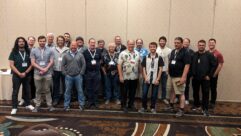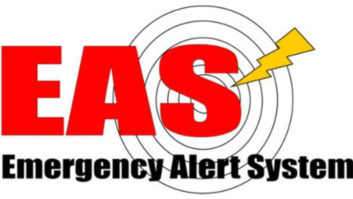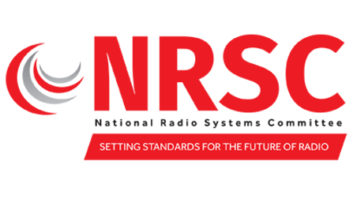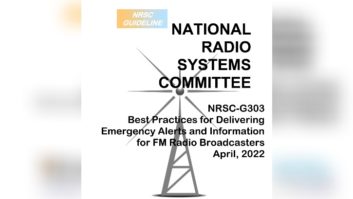This article has been updated to reflect that the president himself will not voice the test.
Also see related story “FCC Tweaks Rules to Allow National EAS Test.”
WASHINGTON — Someday soon, probably this fall, a federal official will speak into a microphone; his or her words will leave Washington and be transmitted across the country via the legacy Emergency Alert System in the first-ever national test of EAS.
Radio stations and their equipment will forward the message; then stations will have 45 days to report how the process went.
The broadcast industry is beginning to learn how a national test of EAS will work. No national test of EAS or its predecessors Conelrad or EBS has ever been performed, even though the national alerting system dates to 1951.
The Federal Communications Commission laid out initial plans in February in an order amending Part 11 rules to allow for the test. The changes were published in the Federal Register in March and are now in effect.
These developments come as authorities evaluate a January test in Alaska that was essentially a statewide trial run for a national-level Emergency Activation Notification. It was the second such test in a year; initial reports indicate the system there has improved since the first test revealed a few trouble spots, according to people familiar with the results.

Jamie Barnett, chief of the FCC’s Public Safety & Homeland Security Bureau, gave an overview of the FCC’s EAS progress in an online seminar. Image courtesy FCC Public Safety & Homeland Security Bureau
This is in anticipation of a true national EAS test as well as the separate but related rollout of Common Alerting Protocol and other new alerting technologies that comprise “next-generation” EAS.
The deadline for all EAS participants to implement CAP-EAS technology is Sept. 30, 2011. Radio stations must be able to receive and decode Common Alerting Protocol v1.2 messages by that date to be in compliance. CAP is an XML-based data format that can be used by local emergency managers to communicate with the public via various alerting technologies.
The FCC’s February order says a nationwide activation of EAS will take place later this year but did not give more specifics. It indicated that the test need not wait until the CAP compliance deadline, leaving open the possibility of a national test earlier, perhaps in summer; but Damon Penn, assistant administrator of the National Continuity Programs Directorate for the Federal Emergency Management Agency, told an EAS webinar audience in February the agency aims to conduct the test in the fall. The FCC has promised broadcasters at least a two-month warning.
As part of the rollout for a national test, FEMA, the FCC and the National Weather Service plan a public education campaign involving workshops and regional outreach. The information, which will include radio and TV public service announcements, targets consumers in general, and specifically people with disabilities and first responders, to help ensure the public is aware of the national test and the benefits of alerts.
With the discussion of CAP and next-gen EAS in general, some broadcast EAS participants have worried that their role in the nation’s alerting system eventually will be abandoned. FCC officials repeatedly have said that radio and TV will remain the backbone of EAS. National Association of Broadcasters President/CEO Gordon Smith recently echoed that point.
Alaskan questions
When a national test of EAS begins, it will include an Emergency Alert Notification or EAN, the live event code for presidential alerts. All EAS participants will be included; broadcasters then must submit test-related data to the FCC within 45 days.
EAS already is subjected to weekly and monthly tests in 550 local EAS areas, tests familiar to broadcasters and listeners. But the commission fears such tests do not expose vulnerabilities or gaps in nationwide coverage.
Officials viewed the Alaska tests as training for a nationwide trial. An EAN was issued by the FEMA Operations Center in Washington on Jan. 26 and sent to radio, television and cable operators across that state.
A FEMA official said it does not consider the exercise “a pass/fail test,” rather one that allows it to establish, assess and validate a baseline for its national-level EAS test and future testing.
While the Alaska test was of the legacy EAS system, FEMA officials have said the agency plans to include CAP and next-generation alerting technologies in future tests and exercises.
“Gaining knowledge was the goal. There were several issues from the 2010 test that were mitigated this time,” said Dennis Bookey, co-chair of Alaska’s State Emergency Communications Committee. The second test addressed concerns such as low audio levels and relay networks not forwarding the message correctly, he said. DASDEC PC-based EAS encoder/decoders malfunctioned at several radio stations because of a programming malfunction within the units, as we reported at the time. In addition, one of the state’s largest cable providers failed to receive the EAN message initially. Several radio and television stations also allowed the test message to pass through twice because of a programming error in their EAS equipment.
The “daisy-chain” nature of the EAS system is a common point of criticism; and the FCC in its order acknowledged that the design is susceptible to single-point failures.
Bookey said there were some “singular station issues” in the second test, mostly in small communities. However, Bryan Fisher, chief of operations for the Alaska Division of Homeland Security and Emergency Management, said, “No new technical difficulties came to light” in the test. “Minor localized malfunctions occurred, as happens in all of our live code testing.”
Representatives of some equipment manufacturers were on hand in Alaska to witness the trial. “Most participated in coordination with FEMA,” Fisher said.
“With the technical challenges with a system like EAS and the length of time between our live tests, we are satisfied our mitigation strategies and efforts paid off.” Some observers wonder whether using Alaska as a proving ground for EAS is adequate.
“I believe that preparing Alaska for a test is one thing. Preparing the nation for a test calls for much more thought and discussion,” said Richard Rudman, vice chair of the California State Emergency Communications Committee.
For one thing, Rudman said, some EAS experts have asked the FCC for a way to test the presidential use without implementing the actual code the president will use if a real EAN is ever issued as a safety precaution.
Rudman also hopes FEMA will give more attention to making sure the origination mechanics of live code tests and real EANs will function properly.
The FCC concludes in its report and order that EAN should be used for the initial national trial but that alternatives may be considered for future trials, including a code called NPT, or National Periodic Test.
Gear questions
In addition to the national test plans, FEMA is moving forward with procedures to determine which EAS encoder/decoders are CAP-compliant. It has developed a method of showing that a device can accept and process messages as specified by CAP v1.2 protocol in the Integrated Public Alert and Warning System profile.
It will not specifically certify EAS gear, but FEMA will post test results to a database as part of the IPAWS Conformity Assessment Program.
Darryl Parker, senior vice president of manufacturer TFT Inc., said, “This testing will allow vendors to include a Supplier’s Declaration of Conformity in a product description on the Responders Knowledge Base website.”
Harold Price, spokesman for manufacturer Sage Alerting Systems, said “FEMA has made it clear that they are not approving or certifying devices. [FEMA] is only determining if the equipment is capable of processing CAP messages.” Price believes FEMA is not officially certifying the equipment because it does not have the authority to do so as the FCC does.
Broadcasters and other EAS equipment users can view compliance test results at www.rkb.us. FEMA hopes to post the first results in March.
The FEMA process is not the only testing to which EAS gear must be submitted. Equipment makers also must pass through an FCC compliance process. The details and timing for that process have yet to be made clear.
Gary Timm, broadcast chair of the Wisconsin EAS Committee, said the most important step for broadcasters at present is for the FCC to release a notice of proposed rulemaking about EAS rule changes and get its rulemaking process underway.
“The CAP clock is ticking, and Sept. 30 will be here before you know it. The FCC has already hinted that the new rules will address equipment certification,” Timm said.
Timm also said questions remain about the planned national EAS test. For instance, it’s unclear if the experiment will be conducted in Puerto Rico and other U.S. territories. Also the FCC has yet to determine if stations with non-participating national status would be required to sign off the air as they would in a real emergency, Timm said.
And yet to be determined is whether the FCC will use the Emergency Action Termination, or EAT, as part of the test. Where the Emergency Action Notification is a notice to EAS participants and the public that activates EAS for a national emergency, EAT means the emergency is over and the EAS is terminated.
Comment on this or any story. E-mail [email protected] with “Letter to the Editor” in the subject line.












